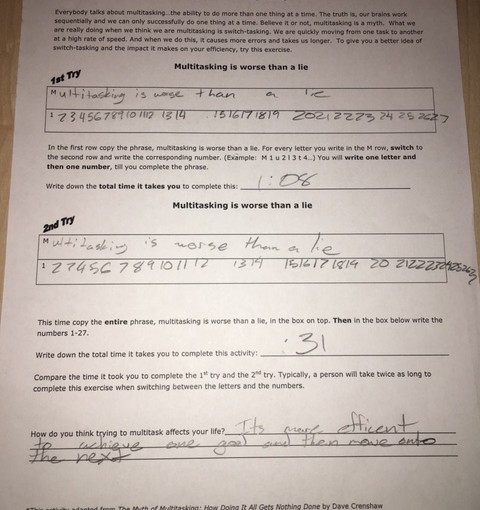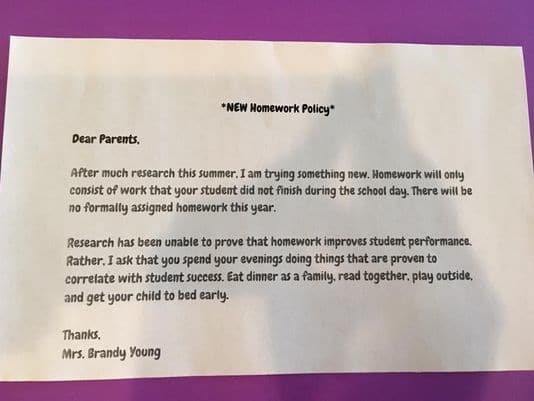Hello everyone! This will be my last post for the semester! Thank you again for following along with my journey this past semester, it has been very enlightening. For this post I am going to be talking about one of the topics I found interesting that we covered in class. The topic I am going to be talking about will be multitasking. This topic stood out to me the most because it is something that I try to do often, especially when it comes to schoolwork.
I have always multitasked throughout the years as a student. I never truly gave it too much thought into thinking twice about doing it because I always assumed that by multitasking I was getting the same work done in half the time it would normally. I also thought that my work was at the same level it would be normally if I just focused on one task at a time. During this class period I was proven completely wrong! After doing more research on the topic I realize just how wrong I was to think I was doing work in half the time and it was high quality work.
The first article I found named “Effects of multitasking on retention and topic interest” by Muhterem Dindar and Yavuz Akbulut. In this article they take a closer look at the effects of the type of multitasking students use and what that does to the student’s retention and interest in the topic. This is what they found, “These findings suggest that the type of multitasking scenario may interact with the nature of the instructional content in influencing affective consequences. In addition, concurrent multitasking seems to interfere with affective outcomes in certain topics whereas sequential multitasking does not.” They found that their interest levels and retention were affected by the type of multitasking they were doing. If the student used sequential multitasking or concurrent multitasking, using sequential multitasking this is when students alternate tasks they are trying to do. In concurrent multitasking students perform at least two tasks at the same time. They found that neither groups performed as good as the control group, however the scores were higher for both, retention and interest, for sequential multitasking. This is because students were focusing on one task at a time, even though they were going back and forth, instead of trying to do two tasks at once.
In a second article I found titled “Learning variables, in-class laptop multitasking and academic performance: A path analysis” by Weiyu Zhang. In this article it looks at how letting students have a laptop in class can affect their academic performance, like the title suggests. The study found, “In other words, when two or more cognitive tasks are being performed simultaneously, there will be decrements in performance in at least one of the tasks. In the case of laptop multitasking during lectures, students work on not only the task of listening to and understanding the lectures but also other tasks such as note-taking, surfing webpages, searching for other information, using SNSs, IMing, and so on. The multiple tasks compete against each other for the limited cognitive capacity students possess and therefore, lead to poorer performance in a midterm exam that heavily relies on the lecture content.” This is a long quote, however it proves the point that I found out in class this semester. When students try to multitasking, their performance drops and they are not putting forth their full concentration and effort to each task. Then they added a laptop in front of the student, and as expected, they used the laptop to message each other. This causes another task they are trying to accomplish on top of all of their schoolwork. They proved that this is too much for the brain to handle, and as a result students’ grades fell.
In another article I found named “Cognitive Predictors of a Common Multitasking Ability: Contributions From Working Memory, Attention Control, and Fluid Intelligence” composed by Thomas S. Redick and many other authors. In this study the subjects completed tests to see if there was a correlation between working memory (WM), attention control, fluid intelligence, and multitasking. The study showed, “Finally, when analyzing the subcomponents of individual differences in WM that are critical for multitasking, we found that capacity and attention control fully mediated the WM and multitasking relationship.” This means that if someone’s attention is on something besides the task at hand his or her working memory, vital to multitasking, cannot perform its function efficiently. This again backs up the idea of multitasking not being the faster and more efficient way to doing schoolwork.
During the in class lesson we worked on a worksheet that tested our multitasking abilities. I will put a picture of the worksheet above. This worksheet asked us to write out a sentence and count the words by writing them down at the same time. I was twice as fast focusing on writing the sentence, then writing the numbers down instead of doing them at the same time. This furthers the point of how multitasking can decrease efficiency because our minds will be overloaded with too much information.
My final thoughts on multitasking are that based off of the evidence I have presented you is that multitasking is not the more efficient way. Students need to focus on one task at a time, as teachers we need to focus on one task before moving onto the next, otherwise our students will not perform at their best! Thank you for reading the blog, have a great day!
-Graham Hevel
CITATIONS
Akbulut, Y., Dindar, M. (2015). Effects of multitasking on retention and topic interest. Learning and Instruction, 41, 94-105.
Engle, R. W., Hambrick, D. Z., Hicks, K. L., Kane, M. J., Meier, M. E., Redick, T. S., Shipstead, Z., Unsworth N. (2016). Cognitive predictors of a common multitasking ability: contributions from working memory, attention control, and fluid intelligence. Journal of Experimental Psychology, 145(11), 1473-1492.
Zhang, w. (2014). Learning variables, in-class laptop multitasking and academic performance: A path analysis. Computers & Education, 81, 82-88.



